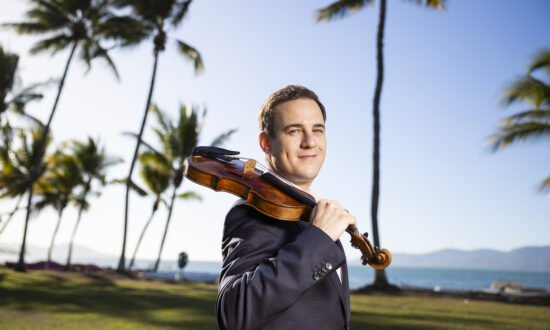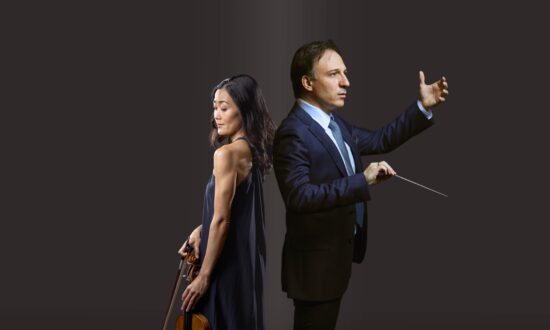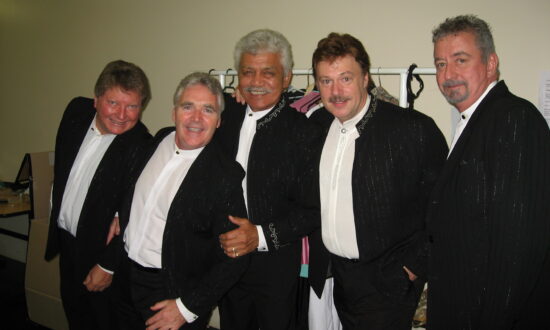A new work from one of Australia’s most liked and instantly recognisable composers is bound to kindle interest, and the special point about Elena Kats-Chernin’s concerto for violin and orchestra, titled Fantasie im Wintergarten, is that it was composed expressly for the Adelaide Symphony Orchestra and its incoming artist-in-association, Emily Sun, to perform.
How the Sydney-based composer – best known, perhaps, for her ballet Wild Swans, but whose prodigious output covers a wider span than almost any other Australian composer – would approach writing anything as standard as a violin concerto was intriguing to ponder. But characteristically, her response was sideways and right out of the box.
Its title, Kats-Chernin tells us, refers to 1920s German cinema and one silent film in particular about “love and betrayal that takes place inside the fairground and circus world” and whose show scenes were shot at Berlin’s historic variety theatre, Wintergarten. Which actual film provided her inspiration she does not go on to say, but The Cabinet of Dr Caligari and others of that ilk might give us an overall picture of emotional content that is intense, grisly and nightmarish.
Fantasie im Wintergarten certainly had some darker moments, as all Kats-Chernin’s music tends to do, but primarily it is a work of pure melodic beauty. Any who were expecting a complex, virtuosic work will have been surprised. Along the way there was a good dose of circus fun and hijinks, but the concerto is more magical than macabre: lyrical and sometimes veering into the sorrowful, it treats the violin primarily as a singer. Lillian’s Aria and her film score for Menschen am Sonntag are precedents elsewhere in her music that come to mind.
Kats-Chernin explained beforehand in her pre-concert talk that it is not a narrative-based concerto, but story-like elements do nevertheless suggest themselves at times. The work begins with simple, symmetrically-phrased melody in the violin that are set against a volatile, continually changing tapestry of sound in the orchestra. Swooping and dance-like gestures from the soloist created an atmosphere of escalating hysteria that reaches a flourishing, virtuosic climax.
Structured as it is in three movements, the concerto feels like a loosely connected series of glimpses into the seamy, comic, cabaret-style entertainments of the Wintergarten, directly appealing to one’s imagination. A beguilingly beautiful melody in the second movement grows out of simple but unexpected harmonies in the orchestra, made the more magical by glistening additions of glockenspiel and marimba. Sliding “blue” notes in the violin and interjections from trumpet, clarinet and snare drum heighten its air of mystery.
The third movement begins with emblazoning rhythmic energy but drifts into a rhapsodic vein that grows in sadness towards the conclusion. This long, variegated finale almost stands as a work by itself and contains some of Kats-Chernin’s most sublime, fluidly expressive music.
As its soloist, Emily Sun was key to the concerto’s conspicuous success in this world-premiere performance. A fresh new work can have the performers guessing, but she played it like it was second nature, with the most wonderful lyricism and polished rhythmic verve. It was no surprise to learn that Kats-Chernin wrote Fantasie im Wintergarten especially with her playing style in mind.
Sun wins profound respect from this performance, and the orchestra itself played with fine precision under conductor Benjamin Northey. The concerto’s rhythmically complex score kept all the musicians busy, and they were right up to the mark.

ASO Symphony Series concert Wild: The orchestra played with precision under conductor Benjamin Northey. Photo: Claudio Raschella
This well-constructed program began in dashing form with the overture Le corsaire by Berlioz, a work that bolts out of the gate like a greyhound and gathers all the pictorial force of a Hollywood film score. The one and only truly “wild” item in this ASO Wild concert, this overture paints nature’s elements and heroic deeds in vivid miniature, and the orchestra gave it good energy. The performance made it sound perhaps too much like film music, though: the particular feverish quality that Berlioz creates through his scurrying violins wanted more intensity.

Get InReview in your inbox – free each Saturday. Local arts and culture – covered.
Thanks for signing up to the InReview newsletter.
In the second half, Saint-Saëns’ Symphony No.3 in C minor, Op.78 (Organ) was resplendent and wonderfully played. In this great Romantic concoction, which throws in the lot (there is piano as well, besides pipe organ), there is just no holding back. Northey’s conception of this work’s magnified shapes was gloriously right. In big works of the repertoire, as we heard in his Pictures at an Exhibition in June last year, he imparts voluptuous width and height to melody while also nailing down rhythm with discipline. This combination worked exactly again in the Saint-Saëns, which really can only be heard live for full effect.
The whole orchestra excelled. Kate Suthers, the ASO’s new concertmaster, plays with a special virility that harnesses the whole string department, and marvelous individual contributions abounded – notably from Peter Kelsall on organ, Michael Ierace on piano and Andrew Penrose on timpani.
But it was the new violin concerto that gave this concert a distinction of its own. To commission memorable new works like this by Kats-Chernin provides the lifeblood for an orchestra, and credit to the ASO for having taken the initiative. On the basis of this conspicuous success, it could step up its commissioning activity.
Wild was presented at the Adelaide Town Hall as part of the Adelaide Symphony Orchestra’s Symphony Series. The orchestra’s next major concerts will be the series of Rachmaninov piano concertos at the Town Hall from May 24.
Support local arts journalism
Your support will help us continue the important work of InReview in publishing free professional journalism that celebrates, interrogates and amplifies arts and culture in South Australia.
Donate Here




